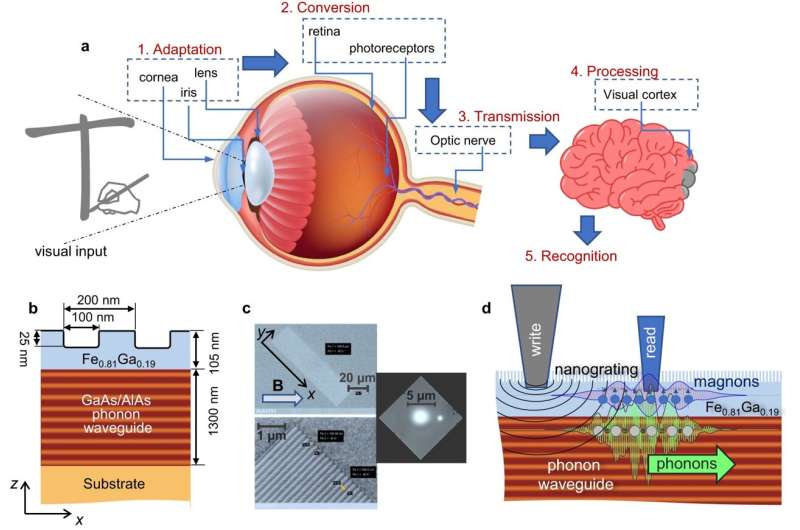This article has been reviewed according to Science X's editorial process and policies. Editors have highlighted the following attributes while ensuring the content's credibility:
fact-checked
peer-reviewed publication
trusted source
proofread
International research team develops new hardware for neuromorphic computing

In the future, modern machines should not only follow algorithms quickly and precisely, but also function intelligently—in other words, in a way that resembles the human brain. Scientists from Dortmund, Loughborough, Kiev and Nottingham have now developed a concept inspired by eyesight that could make future artificial intelligence much more compact and efficient.
They built an on-chip phonon-magnon reservoir for neuromorphic computing which has recently been featured as Editor's Highlight by Nature Communications.
The human sensory organs convert information such as light or scent into a signal that the brain processes through myriads of neurons connected by even more synapses. The ability of the brain to train, namely transform synapses, combined with the neurons' huge number, allows humans to process very complex external signals and quickly form a response to them.
Researchers are trying to imitate the principle of signal transmission and training with complex neuromorphic computer systems—systems that resemble the neurobiological structures of the human nervous system. However, modern technologies are still infinitely far from achieving comparable information density and efficiency.
One of the approaches intended to improve neuromorphic systems is the reservoir computing framework. Here, the input signals are mapped into a multidimensional space known as a reservoir. The reservoir is not trained and only expedites recognition by a simplified artificial neural network.
This results in an enormous reduction of computational resources and training time. A typical example of natural reservoir computing is human vision: In the eye, the visual information is pre-processed by hundreds of millions of the retina's photoreceptors and converted into electrical signals that are transmitted by the optic nerve to the brain. This process greatly reduces the amount of data processed in the brain by the visual cortex.
Modern computer systems can emulate reservoir functions when dealing with digitized signals. However, the fundamental breakthrough will be achieved when reservoir computing can be performed directly with analog signals by a natural physical system, as in human vision.
The international team with researchers from Dortmund, Loughborough, Kyiv, and Nottingham have developed a novel concept that brings such breakthroughs much closer.
The concept suggests a reservoir based on acoustic waves (phonons) and spin waves (magnons) mixed in a chip of 25x100x1 cubic microns. The chip consists of a multimode acoustic waveguide through which many different acoustic waves can be transmitted and which is covered by a patterned 0.1-micron-thickness magnetic film.
The information delivered by the train of ultrashort laser pulses is pre-processed prior to the recognition by conversion to the propagating phonon-magnon wavepacket. Short wavelengths of the propagating waves result in high information density, which enables the confident recognition of visual shapes drawn by a laser on a remarkably small area of less than one photopixel.
Professor Alexander Balanov from Loughborough University, one of the concept's authors, states, "The potential of the physical system proposed as a reservoir was immediately obvious for us because of its amazing combination of variability and multidimensionality."
His colleague Professor Sergey Savel'ev emphasizes the similarity of the demonstrated working principle with the functionality of the human brain: "The functionality of the developed reservoir is based on the interference and mixture of the optically generated waves, which is very similar to the recently suggested mechanism of the information processing in the biological cortex."
Dr. Alexey Scherbakov, who led the project at TU Dortmund University, says, "Our concept is very promising because it is based on conversion of the income signal to high-frequency acoustic waves like in modern wireless communication devices."
"Our acoustic frequency range above 10 GHz is a bit higher than available right now, but it is targeted by the next wireless communication standards. Thus, who knows, probably in a couple of years, your mobile phone will help you make very human decisions."
More information: Dmytro D. Yaremkevich et al, On-chip phonon-magnon reservoir for neuromorphic computing, Nature Communications (2023). DOI: 10.1038/s41467-023-43891-y




















